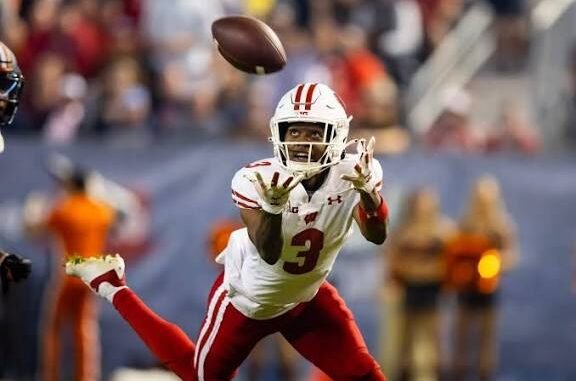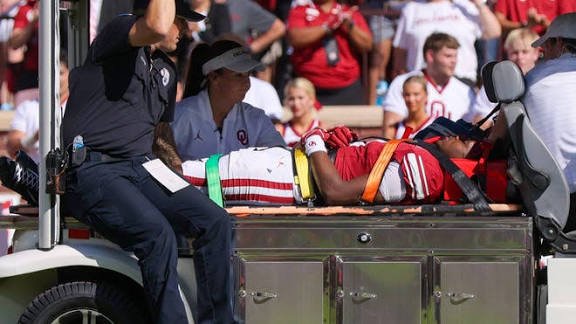
Introduction

On October 4, 2025, college football fans watched in shock as Oklahoma wide receiver Keontez Lewis was involved in a harrowing injury during the Sooners’ home game against Kent State. What began as a routine attempt to haul in a pass turned into a serious scare when Lewis crashed helmet-first into an exposed brick wall beyond the end zone. The imagery quickly spread across social media, sparking concern, debate over stadium safety, and intense scrutiny of his health status.
In this article, we break down what happened, analyze the video, track the medical updates, discuss the brick wall’s role in the injury, and explore implications for player safety. We also include a detailed FAQ to answer the key questions fans and observers are asking.
The Incident: What Happened?
Game context
-
The injury occurred early in the game between Oklahoma and Kent State, at Gaylord Family — Oklahoma Memorial Stadium in Norman, Oklahoma.
-
On Oklahoma’s second offensive play, quarterback Michael Hawkins Jr. threw a deep pass to Lewis that was overthrown.
-
Lewis, in full stride toward the back of the end zone, attempted to extend and catch the ball but could not. His momentum carried him into the brick barrier directly behind the end zone.
-
The wall in that part of the stadium has little or no padding, meaning the impact was directly against exposed brick.
-
Lewis lay motionless on the turf for about 10 minutes as medical staff examined him.
-
He was then strapped onto a backboard, loaded into a cart, and slowly wheeled off the field. Teammates and the crowd showed visible concern.
Video Breakdown & Scope
A number of video clips and highlights of the collision circulated almost immediately across platforms. One such clip: “Oklahoma WR Keontez Lewis CARTED OFF field after scary head-first COLLISION with brick wall.”
What the video shows
-
Lewis diving toward the back line of the end zone as the pass sails just out of reach.
-
The abrupt stop as his head (or helmet) strikes the wall before his body collapses forward.
-
Medical personnel rushing in.
-
A stretcher and medical cart brought onto the field.
-
Reactions from teammates and crowd rising in tension or silence.
Not all angles are available publicly, and many clips are short-form snippets (social media, news outlets). Still, the video evidence leaves little question that the collision was severe and traumatic.
The video also sparked debate on stadium design, boundary safety, and whether walls so close to play areas should have more padding or repositioning. Keontez Lewis injury.
Medical Updates & Injury Status (As of Today)
Initial on-field evaluation
-
After being carted off, news emerged that Lewis was conscious and responsive during evaluation.
-
Oklahoma’s coaching staff and medical team described the early evaluation as “promising.”
-
Coach Brent Venables likened the collision to a “car wreck” in terms of severity, reflecting how violent the impact appeared.
-
Venables also affirmed that Lewis was “alert” and responding to questions, saying “My head’s fine, my legs are fine.”
Diagnostic imaging & tests
-
X-rays taken after the incident reportedly came back negative for broken bones.
-
Lewis was transported offsite for further testing, out of an abundance of caution.
-
Reports say he was walking around in the training room later on, which is a hopeful sign.
-
Oklahoma’s medical staff noted that while early scans were good, further evaluation would be required to assess soft tissue damage, concussion risk, spinal injury, contusions, or other latent issues.
Prognosis & outlook
-
As of now, the consensus is cautious optimism: no fractures, neurological responsiveness, and movement.
-
However, many caveats remain. Soft tissue injuries (spine, neck, muscles), concussion, or post-impact complications cannot be ruled out yet.
-
It may take days or weeks of observation, rehab, and further imaging to understand his recovery timeline fully.
Keontez Lewis: Background & Role in Oklahoma
To understand the significance of this injury, it helps to review Lewis’s journey and role in the Sooners’ offense.
College career path
-
Keontez Lewis began at UCLA in 2021, then transferred to Wisconsin (2022–2023).
-
In 2024, he moved to Southern Illinois and had a productive season, which helped him gain momentum.
-
Ahead of the 2025 season, Lewis transferred to Oklahoma, where he became a starting wide receiver.
2025 season performance
-
Before the injury, Lewis caught 17 passes for 210 yards and 2 touchdowns.
-
In his Oklahoma debut, he had 9 catches for 119 yards and 2 touchdowns.
-
He was seen as a key target and contributor in the Sooners’ aerial attack, especially given his experience across multiple programs.
Given his role and production, any extended absence would impact Oklahoma’s offense planning.
The Brick Wall: Why It Matters
This collision raises larger questions about stadium design, safety boundaries, and how close structures should sit to active play.
Stadium architecture & boundary proximity
-
The brick barrier in question is part of the unpadded wall behind much of Owen Field (Oklahoma’s stadium).
-
The wall is reportedly quite close to the field of play, leaving minimal buffer between live action and exposed structures.
-
Only limited sections of stadium walls are padded (e.g. near corner ramps); much of the barrier is raw brick.
Risk and past precedents
-
In high-speed collisions, players rarely expect to crash directly into immovable structures; most stadiums incorporate buffer zones, softer materials, or padding in high-risk areas.
-
Previous incidents in football (and other sports) have spurred retrofits, padding additions, or barriers moved back to reduce catastrophic injury risk.
-
The proximity and hardness of the brick wall make this kind of collision particularly dangerous.
Oklahoma’s response & potential changes
-
Coach Venables acknowledged the danger and said the university is “evaluating all options” to improve safety.
-
It is likely that Oklahoma will review whether additional padding, structural modifications, or repositioning could reduce future risk.
This incident may prompt not just changes at OU, but across stadiums nationwide, especially in areas where walls abut active play zones.
Implications for Oklahoma & Beyond
For the Sooner offense
-
Losing Lewis — even temporarily — removes a dependable target off the lineups.
-
Opposing defenses may exploit mismatches or adjust coverage knowing depth has shifted.
-
The situation also pressures the coaching staff to adjust routing, red-zone strategy, and personnel deployment.
For player safety norms
-
The collision reignites debates about stadium design, especially rule changes around boundary zones.
-
Governing bodies (e.g. NCAA, athletic associations) might revisit regulations for minimum distances from walls or mandatory padding.
-
Athletic departments may face increasing pressure to invest in safety upgrades, particularly in older facilities.
Public & media fallout
-
The visual severity of the moment (via video) ensures the incident will remain in public memory.
-
It may influence recruiting perceptions (i.e. safety infrastructure at a program).
-
It also adds momentum to lobbying for improved facility standards, not just performance metrics. Keontez Lewis injury.
What Comes Next
-
Further medical evaluation
-
Concussion protocol
-
MRI, CT scans for spinal, soft tissue, ligament or disc injury
-
Neurological assessments
-
-
Recovery planning
-
Rest, physical therapy, gradual return
-
Monitoring for delayed effects (e.g. swelling, disc issues)
-
-
Team updates & announcements
-
Oklahoma staff will issue updates, possibly estimate return timelines
-
They may withhold definitive projections until tests conclude
-
-
Facility safety review
-
Oklahoma may commit to stadium modifications
-
Monitoring how other programs respond may drive broader change
-
-
Media & fan discourse
-
Replays, commentary, analysis will dominate sports discourse in coming days
-
Comparisons with prior injuries and architecture debates will persist
-
FAQs (Frequently Asked Questions)
Q1: Is Keontez Lewis okay?
A1: Early reports are cautiously optimistic. He remained alert, responded to questions, and initial X-rays reportedly showed no broken bones. However, full recovery depends on further evaluation.
Q2: What exactly did he hit?
A2: He collided head-first into a brick wall behind the end zone. The wall is largely unpadded and located too close to the field.
Q3: Was there a video of the collision?
A3: Yes — multiple short video clips surfaced soon after the incident, showing Lewis’ dive and impact, plus the response.
Q4: Has this kind of injury happened before?
A4: While collisions with walls or barriers are relatively rare, other sports have seen similar traumatic outcomes. This incident underscores the need for stadium safety margins and padding. Keontez Lewis injury.
Q5: Will Oklahoma change their stadium design?
A5: OU leadership has stated they are “evaluating all options” for safety improvements. Whether that means padding, relocating walls, or redesigning certain areas remains to be seen.
Q6: When might Lewis return to play?
A6: It’s too early to tell. A return depends on test results, symptom progression, and medical clearance. If everything is favorable, he might return in days or weeks — but that is speculative.
Conclusion
The injury to Keontez Lewis is a sobering reminder that even in a highly controlled environment like a football stadium, unpredictable hazards can lead to serious consequences. His violent collision into an exposed brick wall underscores the delicate balance between competition and safety. While the early medical assessments for Lewis are promising, the full impact — both for him and for stadium safety practices — remains to unfold over the coming days.
As the Oklahoma community and the broader college football world wait for clearer diagnostics, the hope is that Lewis recovers fully and that this incident sparks meaningful upgrades in how stadium boundaries are designed and protected.
